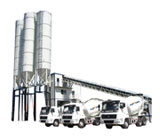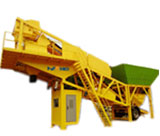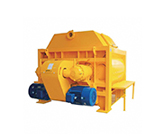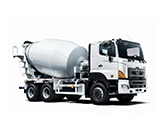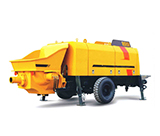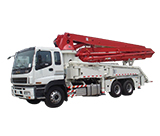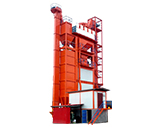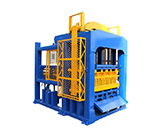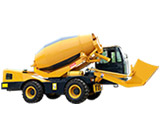Self Loading Concrete Mixer VS Concrete Mixer
2025.05.28
Self loading concrete mixers and ordinary concrete mixers are two different types of concrete mixing equipment, which have obvious differences in structural design, functional characteristics, and applicable scenarios.1. Self-loading concrete mixer
- Core features: It integrates the functions of "automatic loading" and "mixing". It does not require additional loading equipment (such as loaders, manual loading platforms, etc.). It can complete the automatic loading of aggregates (sand, stone), cement and other materials through its own hopper, conveyor belt or lifting device, and realize the integrated operation of "loading-mixing-discharging".
- Common forms: Most of them are mobile designs (such as vehicle-mounted, wheeled traction), and some models can be equipped with automatic weighing systems to realize batching automation.
2. Ordinary concrete mixer
- Core features: It only has the "mixing" function, and needs to rely on external equipment (such as loaders, manual carts, belt conveyors, etc.) to complete material loading. It does not have automatic loading capabilities and needs to be used in conjunction with the loading system.
- Common forms: fixed or semi-fixed (such as the common forced mixers and self-falling mixers on construction sites), mostly used in large mixing stations or fixed construction scenes.


Comparative analysis of self loading concrete mixer vs concrete mixer:
1. Structural design and integration
- Self-loading concrete mixer:
The structure is more complex, including feeding mechanism (such as hopper lifting device, conveyor belt), mixing drum, control system, walking device (such as wheels, chassis), etc., with high integration, equivalent to "all-in-one machine".
Example: A small vehicle-mounted self-loading mixer, the hopper can automatically lift sand and gravel, control the batching through the weighing sensor, and directly unload the material after mixing.
- Ordinary concrete mixer:
The structure is relatively simple, the core is the mixing drum and power system, and external feeding equipment is required (such as a loader to pour the material into the feed hopper), which is a "single function device".
Example: The JS series forced concrete mixer commonly seen on construction sites needs to be fed with a loader or batching bin.
2. Automation and ease of operation
- Self loading concrete mixer:
High automation, can achieve "one-button loading + mixing", some models support intelligent batching (automatic weighing according to preset ratio), low operation threshold, suitable for non-professionals.
Reduce manual intervention and reduce labor intensity (no need to manually carry materials).
- Ordinary concrete mixer:
Manual or mechanical auxiliary loading is required, the batching accuracy depends on external weighing equipment (such as the weighing system of the batching bin), the operation process is cumbersome, and the feeding equipment needs to be coordinated.
High professional requirements for operators (need to coordinate the coordination of feeding equipment and mixer).
3. Applicable scenarios and project scale
- Self loader concrete mixer:
Applicable scenarios: small projects, decentralized construction, mobile operations (such as rural house construction, road repairs, small municipal projects), or scenarios without fixed feeding equipment.
Advantages: No need to build a loading platform in advance, convenient transfer (can be transported by trailer or moved on vehicle), suitable for "stop and mix", saving site preparation time.
- Ordinary concrete mixer:
Applicable scenarios: large construction sites, stationary concrete batching plant, large-scale production (such as commercial concrete mixing stations, bridge projects), which need to form a complete production line with batching bins, conveyor belts, loaders, etc.
Advantages: Large mixing capacity (up to several cubic meters), with automatic feeding system to achieve continuous production, high efficiency.
4. Mixing efficiency and production capacity
- Self-loading concrete mixer:
The mixing capacity is usually 0.5~6.5 cubic meter, the single mixing volume is limited, suitable for small batches and multiple batches of production, and the production capacity is low.
Due to the integrated feeding function, the overall process time is short (feeding + mixing simultaneous optimization), but limited by capacity, the total production capacity is not as good as large equipment.
- Ordinary concrete mixer:
The capacity range is wide (0.5~5 cubic meters and above), and with large feeding equipment, efficient and continuous mixing can be achieved, which is suitable for large-scale concrete production.
Example: JS2000 forced concrete mixer can mix 2 cubic meters of concrete at a time. With batching bin and loader, the hourly production capacity can reach 60~100 cubic meters.
5. Cost and economy
- Self-loading concrete mixer:
Purchase cost: Due to high integration, the price is usually higher than that of ordinary concrete mixers of the same capacity (about 30%~50% higher).
Use cost: No need to purchase additional feeding equipment, saving equipment investment; low labor cost (1~2 people can operate), suitable for limited budget or small projects.
- Ordinary concrete mixer:
Purchase cost: The price of a single machine is low, but it needs to be equipped with feeding equipment (loader, batching bin, etc.), and the overall initial investment may be higher.
Use cost: It is necessary to equip the feeding equipment operator, and the labor cost is high; the equipment maintenance (such as concrete mixer + feeding system) has a wider range and the maintenance cost is slightly higher, but the unit cost is lower during large-scale production.
6. Mobility and site requirements
- Self-loading concrete mixer:
High mobility, mostly wheeled design or can be mounted on a truck, suitable for frequent transfer, low site requirements (only need to level the ground to operate), no fixed foundation required.
- Ordinary concrete mixer:
Fixed models need to cast concrete foundation, which is inconvenient to move; semi-fixed models (such as trailer models) need to be disassembled for transfer, and the site needs to plan the feeding channel in advance (such as the loader's driving route).
7. Maintenance and durability
- Self-loading concrete mixer:
Complex structure (including feeding machinery), many maintenance points (such as hopper lifting device, conveyor belt), regular inspection of mechanical transmission parts (such as chains, bearings), slightly higher maintenance cost.
Because most of them are small equipment, durability depends more on materials and processes, suitable for light and frequent use.
- Ordinary concrete mixer:
The core components (mixing drum, blades) are relatively simple to maintain, and the structural design focuses more on durability (such as the wear-resistant lining of the forced concrete mixer), suitable for high-intensity continuous operation.
How to choose?
- Choose a self-loading mixer:
If the project is small, needs to be moved frequently, pursues convenient operation (less manpower), or lacks feeding equipment, it is preferred to choose a self-loading concret emixer, such as self-built houses in rural areas, small road repair projects, temporary concrete pouring, etc.
- Choose an ordinary concrete mixer:
If it is a large construction site, a fixed production scene, requires high production capacity (large-scale mixing), and has supporting feeding equipment (loader, batching silo), ordinary concrete mixers are more efficient with automated production lines, such as commercial concrete mixing stations and large-scale construction projects.

